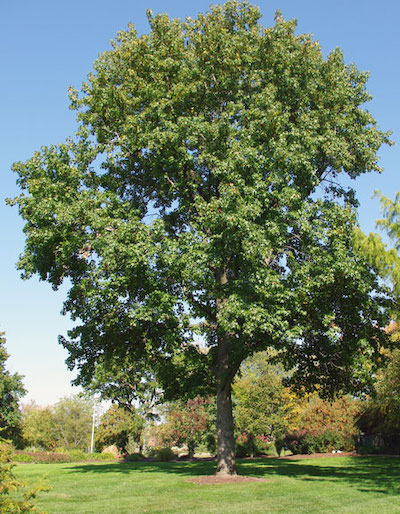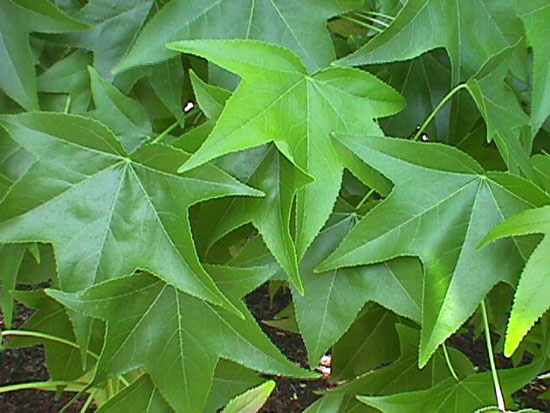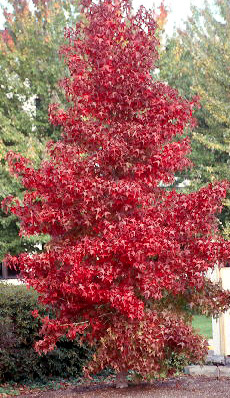American Sweetgum
By Linda Puff, Fairfax Master Gardener
 The American Sweetgum (Liquidambar styraciflua) is a deciduous broadleaf tree widely known for its beauty and colorful leaves through the seasons. Liquidambar means liquid amber and styraciflua is in reference to styrax balsam, which is a type of resin produced by the Sweetgum that can be chewed for medicinal and recreational purposes.
The American Sweetgum (Liquidambar styraciflua) is a deciduous broadleaf tree widely known for its beauty and colorful leaves through the seasons. Liquidambar means liquid amber and styraciflua is in reference to styrax balsam, which is a type of resin produced by the Sweetgum that can be chewed for medicinal and recreational purposes.
The Sweetgum is a large hardwood which can grow over 100 feet (30 m) in height and 3 to 5 feet (1-1.5 m)in diameter, with a coned-shaped crown and grayish brown bark that is deeply furrowed into narrow, somewhat rounded ridges.
The leaves are distinctive, star-shaped with five to seven lobes, dark green and shiny above and paler underneath. They resemble maple leaves but are less palmate and more deeply defined. Maple leaves grow in pairs (opposite) while the Sweetgum leaves are alternate. In the summer, the Sweetgum provides wonderful shade. It typically blooms as the leaves emerge in early to mid-spring. Male flowers open in upright clusters while female flowers on the same tree form spherical dangling clusters that later develop into the characteristic fruits, or gumballs.
The fruit, a 1 to 1-1/2 inch ball (2.5-4 cm) suspended from a slender stalk, is actually dozens of fruits that have fused together. A close look finds that the gumball spikes are arranged in pairs. During the drying process, the balls turn from green to brown and holes appear. Each gumball will produce 30 to 50 seeds that are dispersed by the wind and by animals. Many birds including the northern cardinal, American goldfinch, purple finch, sparrow, red-winged blackbird and wild turkey love the seeds, along with small mammals like the chipmunk and red and gray squirrels.
The young twigs and limbs have distinctive flanges and wing-like growths. The extra wood on the branches makes the Sweetgum prone to ice damage as snow and ice can build up in the crevices, weighing down the twigs and limbs. This tree has earned the nickname of “alligator tree” as the young branches have a scaly, vaguely prehistoric appearance.
The Sweetgum tree prefers full sun with at least six hours of direct, unfiltered sunlight each day. It grows in acidic, loamy, moist, sandy, well-drained, wet and clay soils. Planning is required if this tree is being considered for a landscape due to its large size when mature. The woody, spiky seed balls make the tree best suited for an area far away from buildings and sidewalks. It is a very popular street and park ornamental tree. The Sweetgum should be pruned during the winter, if needed. Iron chlorosis can be a problem if planted in soils with a high pH. Scale insects are the most common insect pests.

Sweetgum leaves
In the spring, the Sweetgum provides a food source for the ruby-throated hummingbird and other nectar feeders. It is a host plant for more than 30 species of butterflies and moths, including the luna moth, one of the most intriguing and exotic of the night-flying moths. It also provides food for the baby promethea moth.
Many homeowners find the Sweetgum tree to be messy. It is a deciduous tree that litters our lawns in autumn with colorful leaves that must be raked. That is only a portion of the mess the tree creates. The major complaint is the thousands of spike-laden fruits that drop from the trees on lawns. The prickly fruits have a number of colorful names including gumballs, goblin balls or monkey balls.
Michael Dirr comments about the Sweetgum in his book: “This lovely tree would be on every gardener’s wish list were it not for the woody, spring, capsular, 1” to 1-1/2” diameter fruit, which abscise through fall and winter.”
There is a podless, fruitless cultivar, ‘Rotundiloba,’ with rounded lobed leaves that grows 60 to 70 feet (18-21 m) at maturity. It may occasionally produce a stray seed pod. To keep seed pods from maturing, prune out any branches with pointed leaves.

Fall color
The Sweetgum also has many redeeming traits. It usually grows in a very straight form, which makes it a good species for timber. Among the hardwoods that blanket the Southern forests, it is second in production only to the oaks. Its wood, which can take a high polish, is used for ornamental woodworking in cabinetry, veneer, baskets and boxes. The wood is also used to manufacture popsicle sticks, chopsticks and other products.
The first mention of the Sweetgum in history, according to the Arbor Day Foundation, came from the diary of a Spanish conquistador in 1519 who watched a ceremony between Cortez and Montezuma in which the “liquid amber” resin from a Sweetgum tree was used. In traditional North American Indian medicine, the resin and inner bark were used to treat diarrhea and as a salve for wounds and skin irritations. The Cherokee used the resin to make a tea to calm the nerves. The Euro-American settlers adopted many of the Indian uses for Sweetgum. Native Americans and colonists (and even more recent inhabitants) chewed this resin. Today, it is used in products ranging from perfume to soaps to soft drinks to candy.
In Appalachia, a concoction of the resin mixed with whiskey was chewed to clean teeth, heal gums and mouth lesions or relieve toothaches. Applying the balsam to the skin might help with chigger and other insect bites. It may also have been used as an insect repellent. It fulfilled these roles for soldiers in the Confederate army during the Civil War. Appalachian Mountain folks spoke of “gummin” time in the spring when the sap was flowing. Sweetgum was a fine chewin’ gum, but it was somewhat bitter.
Three Sweetgum trees are listed on the Virginia Big Trees registry, one in Southampton, one in the City of Alexandria, and one in Surry. The Sweetgum in Southampton, at a height of 140 feet and a crown of 96 feet, is a Virginia State Champion. It was declared a National Champion in 2018 and declared a National Co-Champion in 2019 sharing the title with a tree in Texas. In 2020, the Virginia Champion was dethroned as a National Champion by a larger Sweetgum in New Jersey.
Unlike Thomas Jefferson, George Washington and James Madison, Alexander Hamilton had no special interest in gardening. However, when it came time to plant trees at The Grange, his estate in what is now Upper Manhattan, Hamilton chose to plant 13 Sweetgum trees to represent the original 13 colonies.
While the Sweetgum gumballs can be a nuisance in many landscape situations, the little gumballs are very popular with crafters. Christmas kissing balls, wreaths, potpourri and dried arrangements are a few of the items made using gumballs. Invite the children and grandchildren to come for a day of crafting where they can make gumball mice, ducks, owls and snowmen. You can spray them with snow and glitter, paint them, add eyes, ears, hats, scarves and more. Place the gumballs in a bowl or jar with small pinecones for an autumn display. I will share with you that my neighbors who have Sweetgum trees are most happy to see me coming with my plastic bags.
Given the right location, a Sweetgum will delight throughout the year. As the days grow shorter, the temperatures drop and after other trees have ended their fall color display, the Sweetgum will continue with leaves from yellow to orange to red to purple.
References
• Common Native Trees of Virginia, Tree Identification Guide, Virginia Department of Forestry
• Out My Backdoor: In Defense of the Sweetgum Tree, Terry W. Johnson, Go Fish Education Center,
Georgia Department of Natural Resources
• Sweetgum Tree, Tree of the Month, Chris Anderson, White House Natives
• Sweetgum Plant Fact Sheet, Diana L. Immel, United States Department of Agriculture, Natural
Resources Conservation Service
• Economic Botany and Cultural History: Sweetgum, Rob Paratley, Urban Forest Initiative, University of
Kentucky
• Sweetgum, Tree Guide, Arbor Day Foundation
• A Tree for All Seasons — Sweetgum, Steve Carroll, Northern Virginia Cooperative Living
• Sweetgum (Liquidambar styraciflua) 2901-1072, Alex X. Niemiera, Virginia Cooperative Extension
• Virginia BigTree Program, Virginia Tech
• Dirr’s Hardy Trees and Shrubs: An Illustrated Encyclopedia, Michael A. Dirr